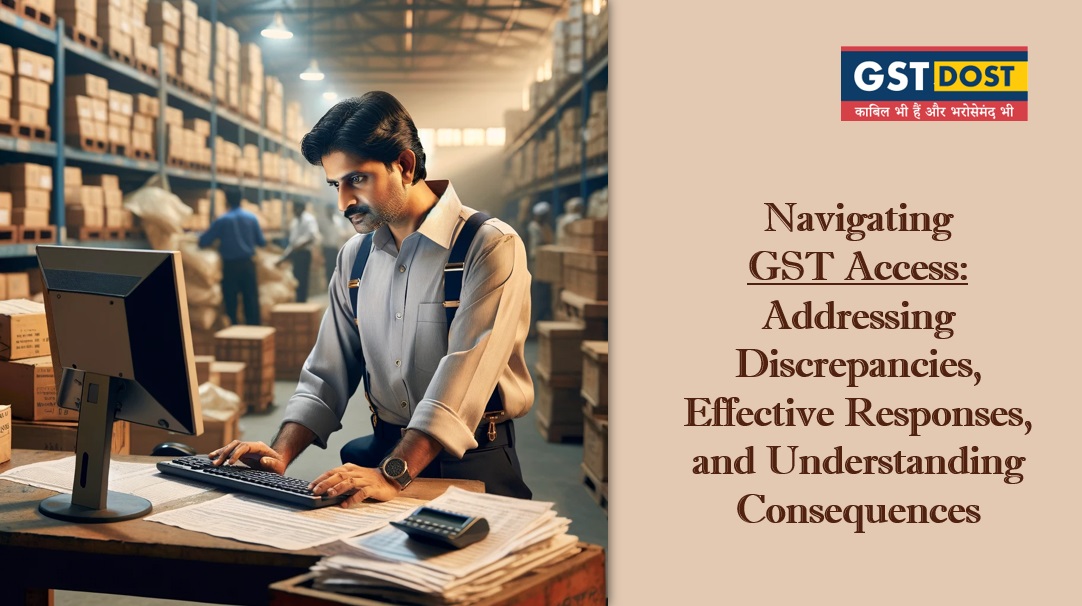Navigating GST Access: Addressing Discrepancies, Effective Responses, and Understanding Consequences
GST DOST's BLOG

Namaste DOST!
It is crucial for businesses in India to understand Goods and Services Tax (GST) compliance. One critical aspect of this compliance is the GST Access to Business Premises, which is authorised under Section 71 of the CGST Act, 2017. This access ensures accurate financial reporting and protects government revenue.
This blog has you covered if you want to learn more about the GST Access process. It provides a detailed overview, emphasising gaining access, resolving discrepancies, requesting extensions, and the potential consequences of non-compliance or leniency.
Understanding "Access"
"Access" marks the beginning of the GST inspection process, which grants GST officers authority to enter a business's premises for inspection. This is a crucial phase that allows for the verification of a business's financial transactions against its actual records.
During this initial "access" phase, a GST officer examines the business's books of accounts, records, documents, and software on-site. This step is essential in ensuring compliance and preventing revenue loss to the government. It is a less intrusive approach than search and seizure operations, focusing mainly on verification and compliance checks.
Authorised under Section 71 of the CGST Act, 2017, GST access is vital for compliance verification, allowing GST officers to inspect any location associated with a registered business. This includes not only the principal place of business and any additional locations listed on the GST Registration Certificate but also warehouses, godowns, service rendering sites, places where books of account are kept, or any location where business is conducted, including through an agent. The primary goal is to conduct audits, scrutiny, verification, and checks crucial for preventing revenue leakage and ensuring adherence to GST laws.
Let's look at a case study. Aarav owns a popular textile emporium in Jaipur, which is registered under GST. Besides his main showroom, he also operates a warehouse on the city's outskirts, which is not listed on his GST Registration Certificate. A GST officer, utilising the authority to inspect any business operation site, conducted an access visit to Aarav's warehouse. There, the officer uncovered discrepancies in the stock records, identifying significant unaccounted inventory. This case underscores the importance of maintaining accurate records and compliance across all business locations, not just those officially listed under the GST Registration.
What to do if Discrepancies are intimated.
Once the access phase is completed and a GST officer has identified discrepancies, the business is officially notified of these findings via a notice. The notice provides the business with a specific timeframe, starting from the date of receipt, within which to file objections. Discrepancies may include issues such as misclassification of tax rates, short payment of tax, and incorrect claims of input tax credit.
Steps to Address Discrepancies:
To address any discrepancies, you need to take the following steps:
1. Review the Discrepancy Notice: Start by carefully reviewing the details of the discrepancy as outlined by the GST officer.
2. Gather Evidence: Next, assemble all relevant documents, records, and explanations that support your position regarding the discrepancy.
3. Decide the Course of Action: After gathering the necessary evidence, you need to decide on the appropriate course of action.
- File an Objection: If you believe that the discrepancy identified is incorrect, you should file an objection. This objection must be supported by compelling evidence and reasons to dispute the discrepancy.
- Rectify the Discrepancy: If you acknowledge the discrepancy as accurate, immediate action is required to rectify it. This involves promptly making necessary payments using the DRC-03 form on the GST portal.
By taking these steps, you can effectively address any discrepancies that may arise and ensure compliance with GST regulations.
Let's take a case study of Tech Innovations. Upon receiving the discrepancy notice, Tech Innovations identified that a software glitch led to the underreporting of sales for a specific quarter. They compiled all necessary evidence, including software logs and revised financial statements, and addressed the fall in tax with interest. However, to clarify the situation, they chose to file an objection regarding the non-payment of penalty with the GST department.
File Extension
Businesses may require additional time to address discrepancies or file an objection. If the 15-day period from the date of receipt of the notice is insufficient, they can request a formal extension. However, it's important to note that the decision to grant this request lies solely with the inspecting officer. The request should be supported by genuine, convincing and specific reasons. These reasons should be time-sensitive and substantiated by appropriate evidence.
For instance, let's consider a case study of "Tech Innovations." They need more time to compile the necessary documents and fix the software glitch identified. They submit a formal extension request to resolve the issue comprehensively, providing a clear and justified reason for the delay. They also propose a new deadline, extending the timeline by an additional 10 days. Their request is supported by evidence of their ongoing efforts to address the discrepancy. This includes communications with their software provider, underscoring their commitment to resolving the issue as quickly and efficiently as possible.
Consequences of Non-Compliance or Leniency.
It's crucial not to overlook any discrepancies identified during a GST inspection and to file an objection promptly. Failure to do so may lead to serious consequences, such as search and seizure proceedings under Section 67 of the CGST Act, summoning to appear in person and provide a statement under oath as per Section 70 of the CGST Act, a show cause notice under Section 74 of the CGST Act, and cancellation of GST registration under Section 29(2)(a) of the CGST Act 2017. Non-compliance can also attract significant penalties under Section 122(1) of the CGST Act.
For instance, a small electronics retailer named "Gadget Galaxy" in Mumbai overlooked discrepancies identified during a GST inspection, which resulted in a delay in addressing them. Consequently, the retailer faced a search and seizure operation, substantial penalties under Section 122(1), and a show cause notice for the cancellation of its GST registration. This example highlights the importance of responding promptly and diligently to discrepancies noted during GST inspections.
Another example is "Samar Sales" a competitor of "Tech Innovations," who ignored a discrepancy notice regarding unreported sales. As a result, the GST department initiated search and seizure proceedings against them, issued a show cause notice for tax evasion, and blocked their Electronic Credit Ledger. "Samar Sales" faced significant penalties, which severely impacted their business operations.
Conclusion: The Path to Compliance
It's crucial to grasp the intricacies of GST inspections and adeptly manage discrepancies to ensure compliance and a smooth business operation. Challenges are inevitable, but the way you address them can significantly influence the outcome, as Tech Innovations experienced.
To confidently navigate GST inspections, it's important to maintain meticulous records, understand your responsibilities under GST, and promptly address any issues. Adopting a proactive rather than a reactive stance ensures that your business remains operational and prospers in an environment that values transparency and compliance.
It's worth noting that GST inspections aim to promote fairness and compliance across the business landscape rather than imposing penalties. It fosters a healthier and more equitable business environment for all.
By understanding the process and responding appropriately to discrepancies, businesses can avoid severe consequences and continue to operate successfully within the legal framework of GST.
Best regards,
DOST Vikash Dhanania

₹31.95 Crore Fake ITC Fraud Busted by CGST Delhi South; Company Director Arrested [News]
CBIC Notifies New Rule 14A – Quick GST Registration Option for Small Taxpayers [News]
Repacking from Bulk to Retail Can Amount to Manufacture Under GST [Blog]
Heard by One, Cancelled by Another: Why the Listener Must Decide [Blog]
Gujarat HC says:“Phone calls don’t count as hearings!”Know your rights under Sec 75(4) [Video]
Know GST Rate of HSN 3926 | GST DOST [Video]


